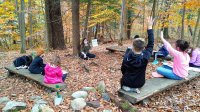Getting Started With an Outdoor Classroom
A Vermont elementary school teacher describes lessons she has moved outside in an effort to help students connect with nature.
Your content has been saved!
Go to My Saved Content.In the throes of the pandemic lockdown in April and May, my saving grace was the nature walks I took with my children after lunch and before more on-screen meetings. The peace and revitalization I found helped me make it through each day, each week, and continue to be there for all the people who needed me.
I think many of us experienced this kind of reconnection with nature, and I was determined to bring this experience to my students when we moved to hybrid teaching in September.
Unlike the teachers and classrooms that are spending all day outside, I decided to start small. I have two hybrid groups, and on each group’s last in-person day of the week (Tuesday and Friday), from 2 until 2:45 my fourth graders are in the woods behind our school as part of our English language arts block. I call the blocks Trees Tuesdays and Forest Fridays.
4 Activities That Work Well Outside
1. Read-alouds: This works especially well with books tied in with science units. Students can bring clipboards for response activities. We’ve read Seeds Move by Robin Page, Three Lost Seeds by Stephie Morton, and Quirky, Jerky, Extra Perky by Brian P. Cleary—a book about adjectives that we read before observing seeds. I had my students listen to a second read of Seeds Move and then write all the verbs from the book connected to the idea of dispersal.
I love doing read-alouds in the woods, and the change of scenery and the brief walk seem to refocus students’ tired minds.
2. Observations: Observing nature can be tied into many parts of the curriculum. In late September we scavenged for seeds, looked at them closely, and then drew them, described them with adjectives, and determined their mode of travel.
We also experienced the joy of discovering animals and learning about them on the spot. One day, for example, my students had just finished a lesson and had some free exploration time in the woods. All of a sudden, a mix of excited and repulsed cries rang through a clearing. A few of my students had discovered something. Socially distancing, we took turns looking at this unidentified creature and used our adjectives to describe it. It was fat. It was slimy. It had spots like a leopard. On a hunch, I googled “leopard slug” on my phone, and that’s what it was. I’m a native Vermonter, but I had never seen such a mollusk.
On subsequent visits to the woods, both of my hybrid classes have found leopard slugs, and salamanders too, hunkered down under a rotting log—a dark one and an orange one together. What made them different? Out came Google so we could find out. I love the combination of planned ELA cross-content lessons and free exploration and discovery in our woodland habitat.
3. Writing: My students periodically have an assigned quick write. Sometimes I give them an image for inspiration and sometimes the forest is their muse. They have to write for three minutes straight and then count and graph their words. I give them a “stuck word” to use when writer’s block strikes. Our first quick write this year came after we watched an episode of the BBC series Hidden Kingdoms called “Secret Forests,” and the stuck word was acorn.
We also do some of our drafting in our writer’s notebooks in the woods, and our first writing piece is a narrative we’re calling Seed Stories: The Journey of a Seed Leaving Home. We read and summarized with SWBST (Somebody Wanted But So Then) the two stories In A Nutshell and The Dandelion Seed’s Big Dream, both by Joseph Anthony, and then had a lesson in the woods on different hooks. Students drafted an introduction for their story using descriptive setting, onomatopoeia, dialogue, and descriptive action.
4. Meditative moments: Are you focusing on social and emotional learning this year? Breathing techniques and strategies to quiet the mind can be quite helpful. The peace of an outdoor classroom can help to calm anxious minds and bodies.
Bring a chime with you and have your students practice settling in and just listening. My students sat in silence for two minutes and then described what they had experienced. I instructed them to close their eyes and relax their bodies, and follow each sound with a flashlight in their mind to really focus on it. What did they hear? How did they feel? “You heard the wind? What did it sound like? Was it whispering? Was it rustling the dry leaves?”
When students are getting antsy or anxious back in the classroom, you can refer to these moments and ask students to “find their moment.” Encourage them to sit on the floor with a hand over their heart, or strike a tree pose with their eyes closed, to bring back the calm of the forest.
For the last five to 10 minutes of our outdoor class time, we have Free Explore, and it’s honestly the most joyous part of my week. With giant logs to climb, forts to build, and nooks and crannies to check out, my students are carefree and happy. And you know what? So is their teacher.
